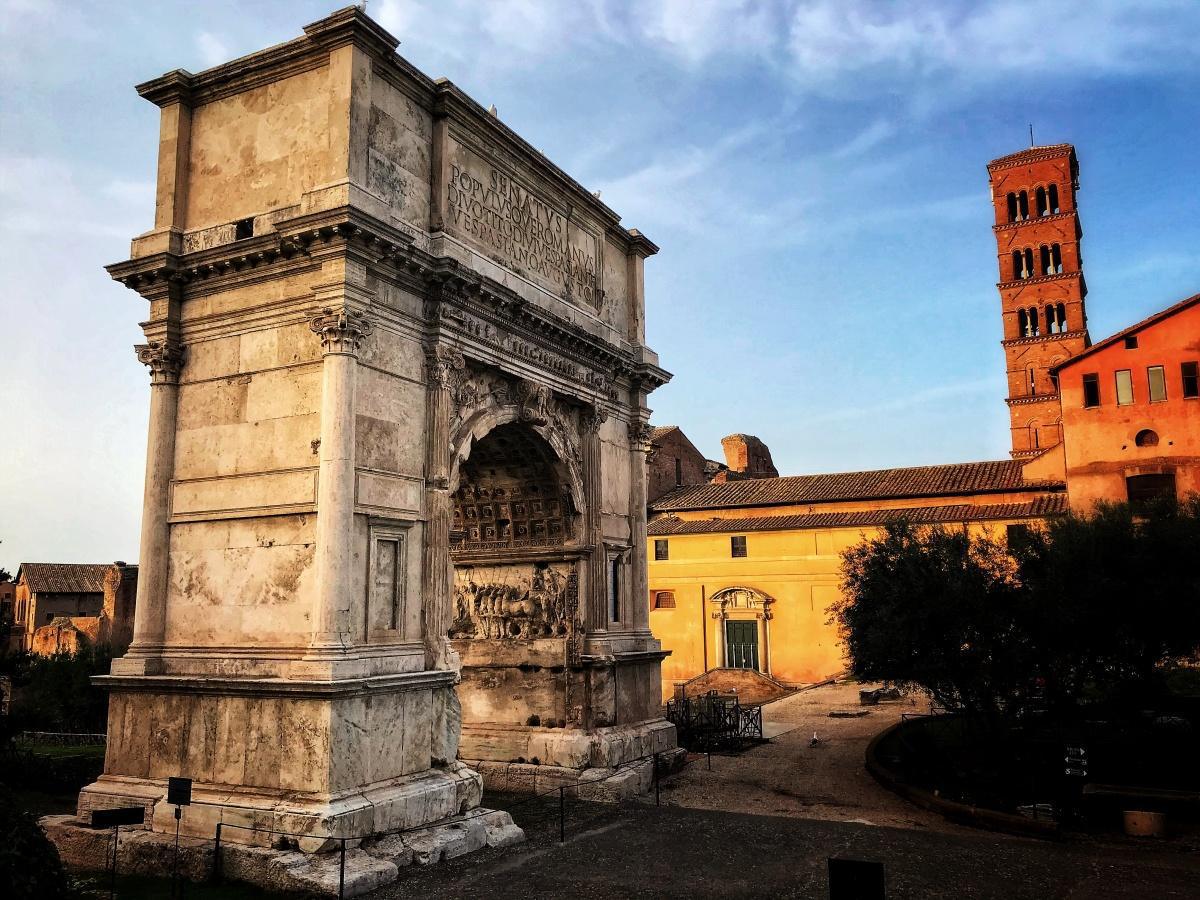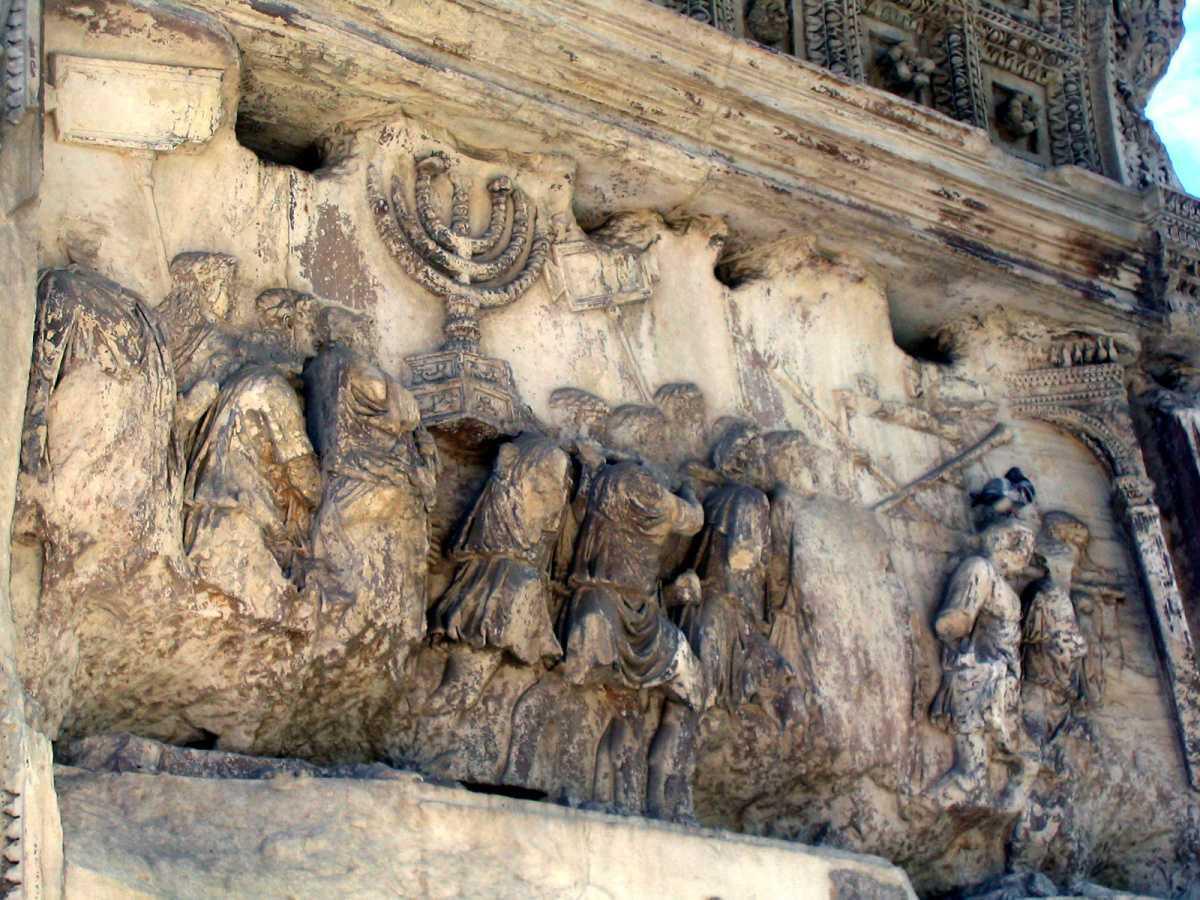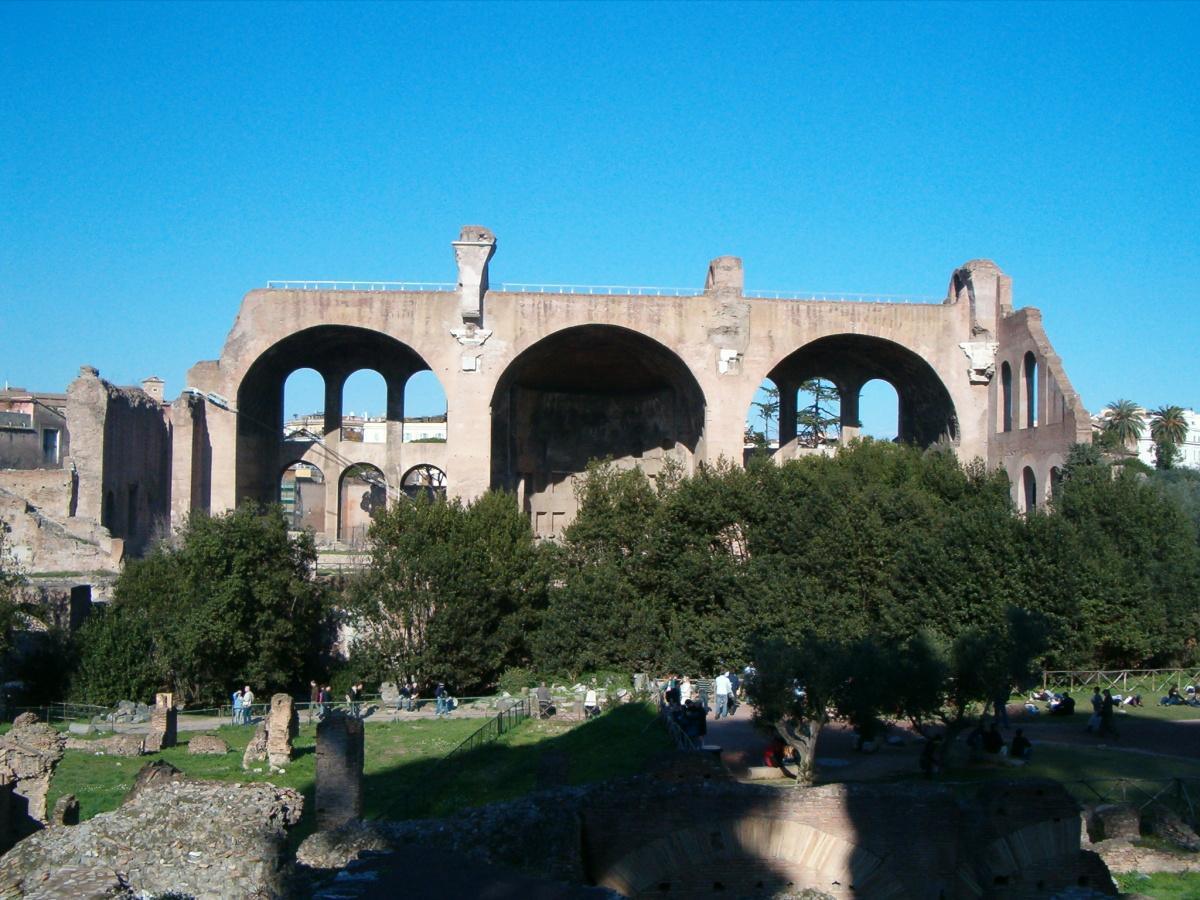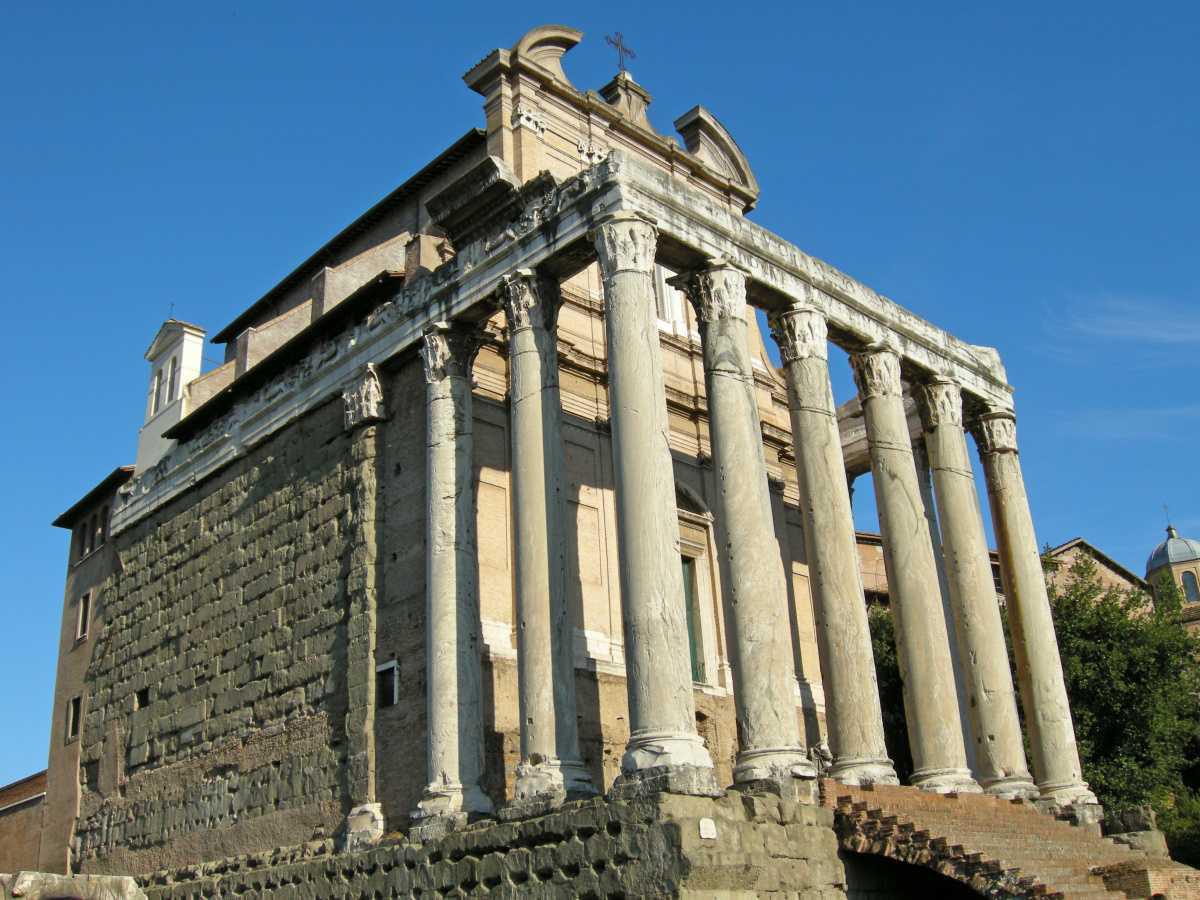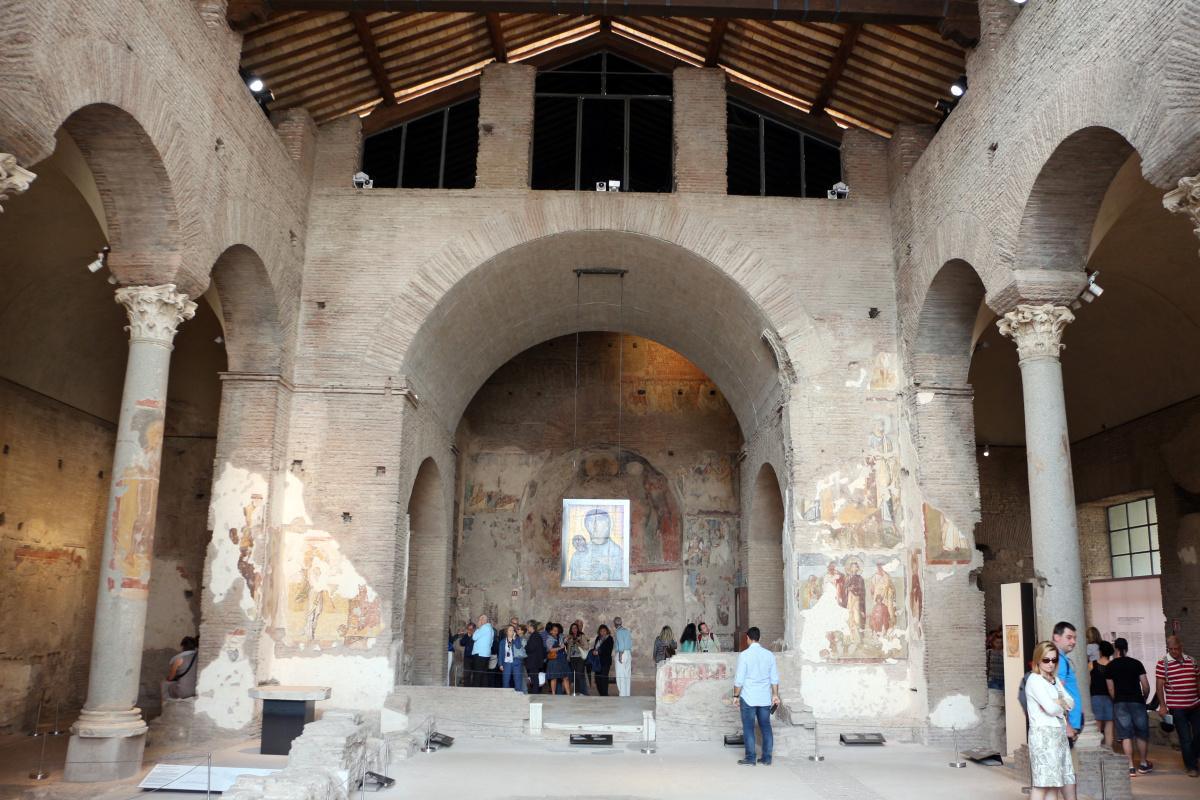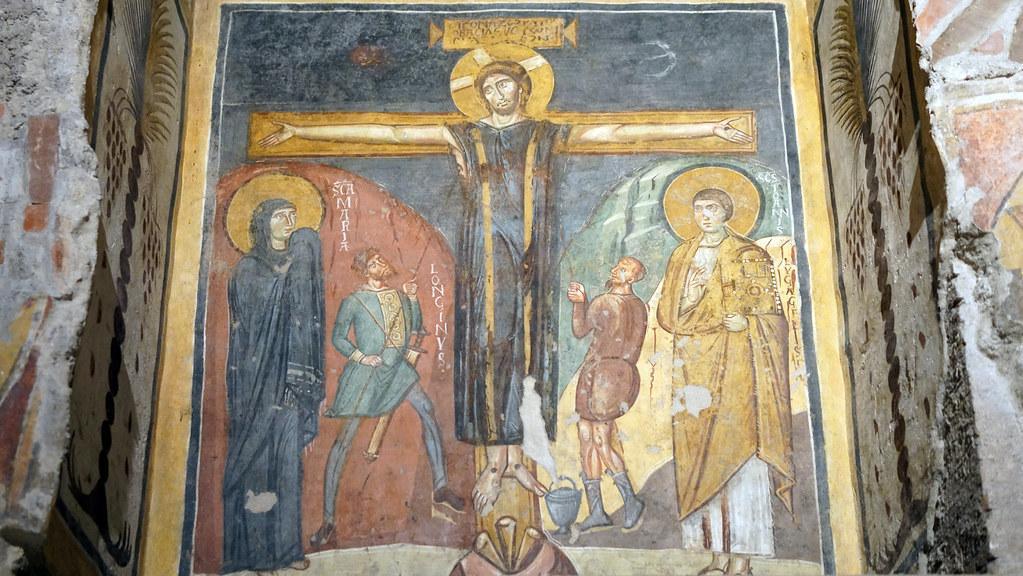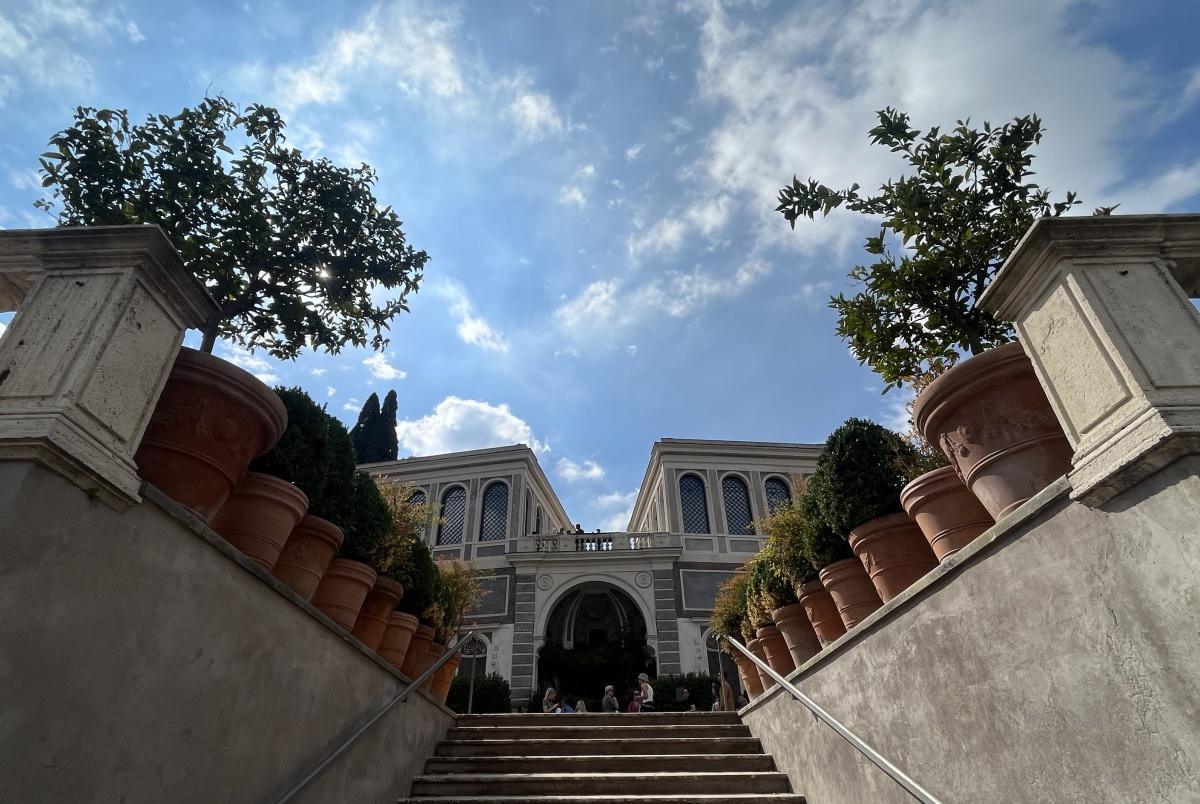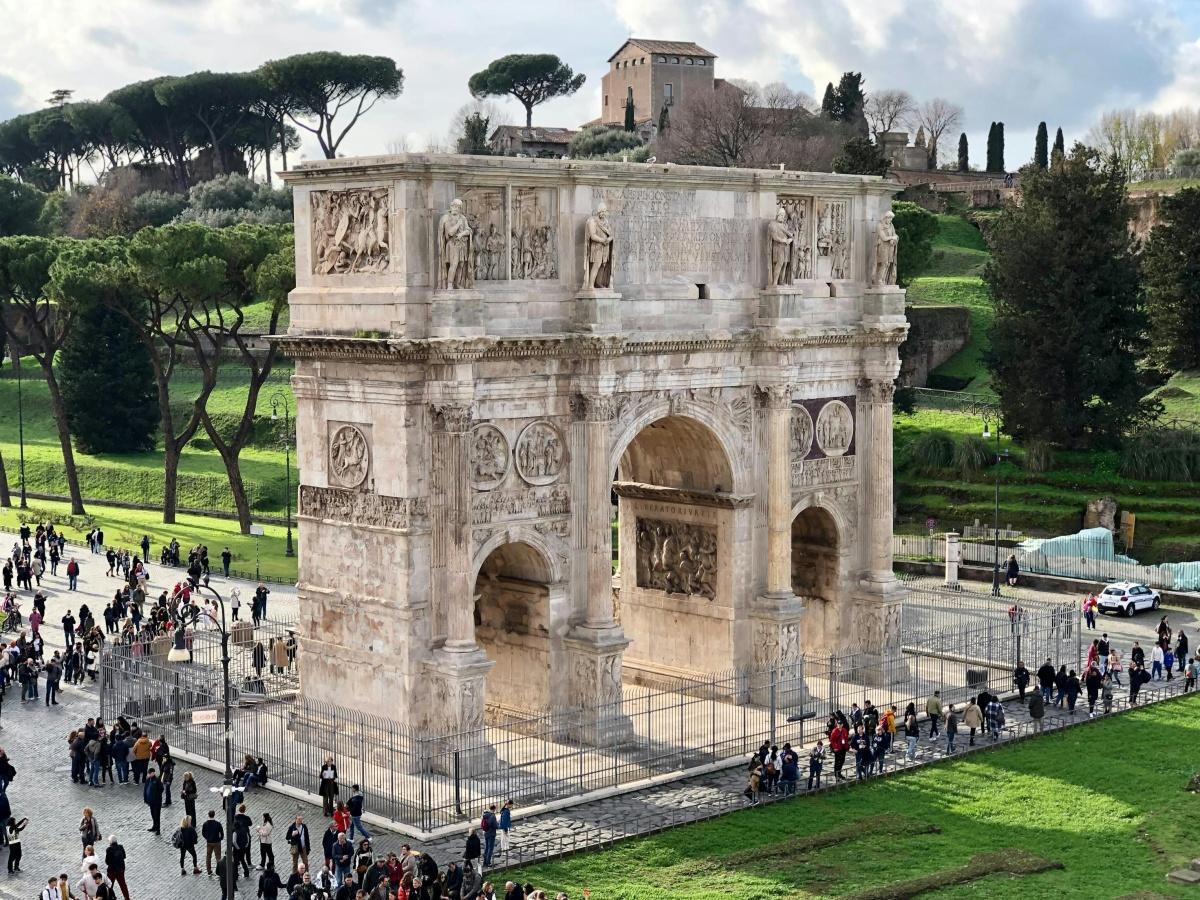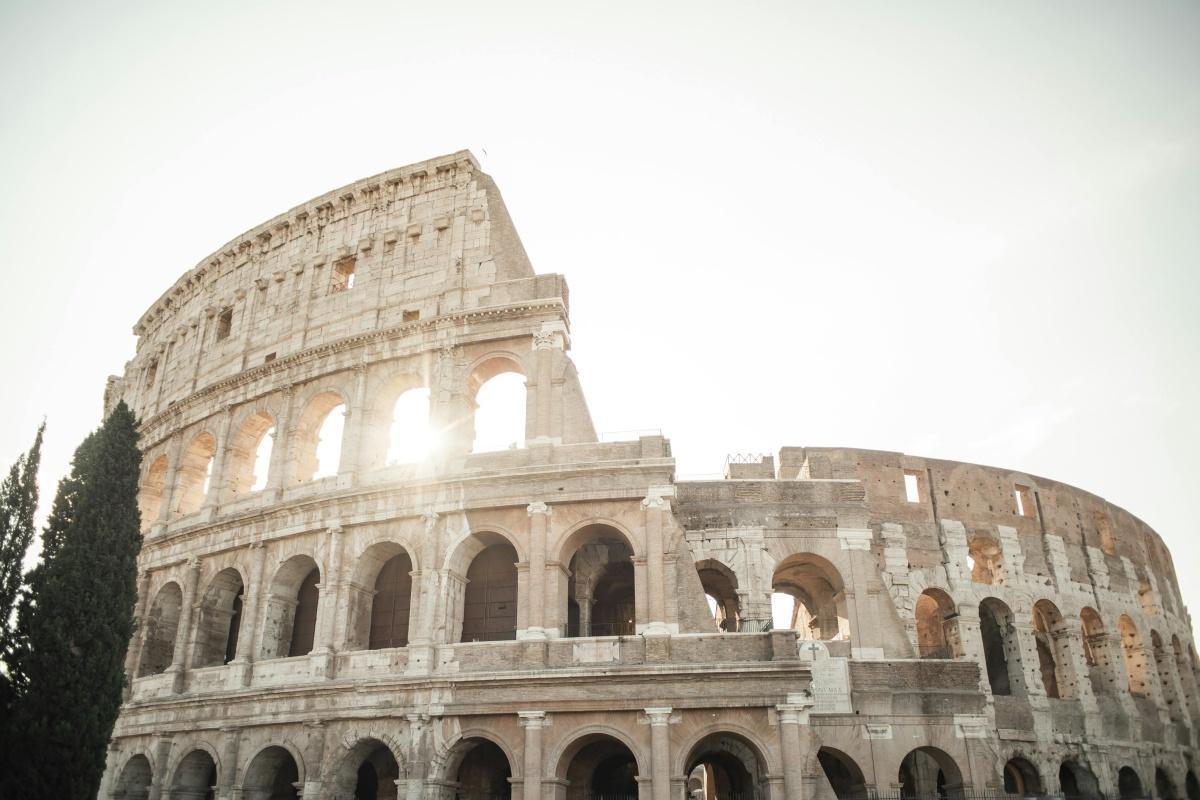
Roman Forum
Rome Rome RM
Political, commercial and religious center of ancient Rome, home to several churches
Tickets | Hours | Map | Photos
The Roman Forum, once the heart of ancient Rome, saw many of its pagan temples transformed into Christian churches following the legalization of Christianity and its establishment as the empire’s official faith. Among these is Santa Maria Antiqua, a rare survivor of early Christian Rome, still accessible within the Parco Foro Romano. This 6th-century church preserves stunning frescoes, offering a glimpse into the transition from pagan worship to Christian devotion.
Outside the Forum, several historic churches remain open to visitors at no cost. San Sebastiano al Palatino, Santa Francesca Romana, and Santi Cosma e Damiano stand as testaments to this sacred transformation. San Giuseppe dei Falegnami, dedicated to St. Joseph the Carpenter, houses the Mamertine Prison, where both St. Peter and St. Paul were held at different times. Tradition holds that St. Peter miraculously caused a spring to emerge in his cell, using the water to baptize his jailers.
Not all ancient churches survived the passage of time. Several were lost in the 20th century when Benito Mussolini commissioned Via dei Fori Imperiali, a grand avenue linking the Colosseum to Piazza Venezia. This construction project reshaped the historic landscape, erasing some of Rome’s sacred past, yet the remaining churches continue to stand as guardians of the city’s enduring faith.
Sites Inside the Roman Forum with Christian Significance (Paid Admission)
-
Arch of Titus
-
Basilica of Maxentius and Constantine
-
Church of San Lorenzo in Miranda (Temple of Antoninus and Faustina)
-
Church of Santa Maria Antiqua
-
Farnese Gardens of the Palatine Hill
Sites Adjacent to the Roman Forum with Christian Significance (Free and/or Separate Paid Admission)
-
Colosseum (Holy Week Via Crucis)
-
Arch of Constantine
-
Santa Francesca Romana
-
Church of Sts. Cosmas and Damian (Temple of Romulus)
-
Church of Santi Quirico e Giulitta
-
Church of the Most Holy Name of Mary at the Forum of Trajan
-
Church of Santa Maria di Loreto
-
Trajan's Column (Statue of St. Peter)
-
Church of Santa Martina e Luca Martiri
-
Mammertine Prison (Carcer Tullianum) – Imprisonment of Peter and Paul
-
Church of Saint Mark the Evangelist al Campidoglio
-
Basilica of Santa Maria in Aracoeli
-
Church of Santa Maria della Consolazione
-
Church of Saint Anastasia on the Palatine
-
Circus Maximus (Site of Christian Martyrs)
-
Church of Sts. Giovanni e Paolo
-
Church of San Gregorio al Celio
-
Basilica of San Clemente
-
Church of Saint Sebastian on the Palatine
-
Church of Saint Bonaventure on the Palatine
Arch of Titus
The Arch of Titus, standing at the entrance to the Roman Forum, commemorates the Siege of Jerusalem in 70 AD, a decisive Roman victory led by General Titus during the First Jewish-Roman War. This brutal campaign saw the destruction of the Second Temple, a moment of immense loss for the Jewish people and a turning point in history. The triumphal arch, commissioned by Emperor Domitian after Titus’ death, stands as a lasting symbol of Rome’s power and conquest.
Carved into its inner reliefs are scenes of Roman soldiers carrying away sacred treasures from the Temple, including the Menorah, the Table of Showbread, and the silver trumpets. These stolen artifacts, paraded in a victory procession, remain among the most striking visual records of the siege.
For Christians, this event fulfilled Jesus’ prophecy in Matthew 24:2, where He foretold the Temple’s destruction, marking a shift from temple-based worship to the new covenant established through Christ. The arch, once a testament to imperial might, now stands as a silent witness to the trials faced by both Judaism and early Christianity, preserving the echoes of an ancient world forever changed.
Details of the Menorah Relief
-
Scene Depiction: The Menorah Relief on the Arch of Titus captures a pivotal moment in history, depicting Roman soldiers carrying the sacred treasures plundered from the Second Temple in Jerusalem. Among these is the Menorah, the seven-branched candelabrum that stood as a symbol of God’s presence in the Temple. The relief shows the Menorah held aloft as part of a victory procession, with soldiers marching through the streets of Rome in celebration of Titus’ triumph. Each branch of the Menorah is adorned with stylized floral designs, meticulously carved to reflect its elaborate craftsmanship.
-
Symbolism: For the Jewish people, the Menorah was a sign of divine light and guidance, a central fixture in Temple worship. Its removal from Jerusalem and display in Rome symbolized not only the loss of the Temple’s sanctity but also the subjugation of a people whose religious identity was deeply tied to its presence. For the Romans, the relief served as a declaration of imperial dominance, showcasing their victory over a once-powerful Jewish state.
-
Historical Context: Christians have long interpreted the scene in light of Jesus’ prophecy in Matthew 24:2, where He foretold the destruction of the Temple, signaling a transition from the old covenant to the new one established through Christ. The fall of the Temple, depicted so vividly in the arch, became a profound moment in salvation history, underscoring the changing spiritual landscape of the ancient world.
-
Artistic and Cultural Impact:
Artistically, the relief is one of the only surviving ancient depictions of the Menorah, offering scholars and historians a glimpse into its original form. The Arch of Titus, through this imagery, remains a lasting testament to the cultural and religious upheaval of the era, preserving in stone the echoes of a faith tested by history.
Basilica of Maxentius and Constantine
The Basilica of Maxentius and Constantine, completed in 312 AD, stands as one of the most ambitious architectural feats of the Roman Forum. Initially commissioned by Emperor Maxentius, the basilica was later completed by Constantine the Great following his victory at the Battle of the Milvian Bridge. This vast structure, with its soaring vaulted ceilings and immense columns, once served as a public and administrative center, reflecting the grandeur of imperial Rome.
Designed with a central nave flanked by side aisles, its architectural form influenced the development of early Christian basilicas, shaping the design of later churches throughout the empire. Constantine’s completion of the project marked a significant shift in Roman history, symbolizing both his consolidation of power and the empire’s gradual embrace of Christianity.
Over the centuries, the basilica suffered extensive damage. A major earthquake in 847 AD caused the collapse of much of its vaulted ceiling, while another in 1349 AD further reduced its towering structure. Like many Roman monuments, it was quarried for materials, with its marble and stone repurposed for later buildings, including St. Peter’s Basilica in Vatican City. Its innovative yet unsupported vaulting left it particularly vulnerable, and natural disasters and neglect led to its present ruinous state.
Despite this, the remaining portions, especially the massive central nave arch, continue to evoke the majesty of its original form. The basilica stands as a testament to the architectural genius of late antiquity, bridging the worlds of pagan Rome and the Christian empire to come.
Church of San Lorenzo in Miranda (Temple of Antoninus and Faustina)
The Church of San Lorenzo in Miranda, set within the ancient Temple of Antoninus and Faustina, stands as a striking example of Rome’s transformation from a pagan empire to a Christian stronghold. Originally constructed in 141 AD by Emperor Antoninus Pius in honor of his deified wife, Faustina, the temple was later rededicated to the emperor himself following his death.
By the 7th or 8th century, the structure was converted into a Christian church dedicated to Saint Lawrence, the deacon martyr who suffered for his faith under Roman persecution. Despite this transformation, the massive Corinthian columns and richly adorned frieze of the original temple remain intact, blending seamlessly with the church’s later additions.
Inside, the church preserves notable religious artworks, reflecting its enduring role as a sacred space. Its presence within the Roman Forum, once the heart of imperial power, symbolizes the triumph of Christianity over paganism, marking a profound shift in Rome’s religious identity.
This fusion of ancient Roman and Christian architecture makes San Lorenzo in Miranda a unique testament to the cultural and spiritual evolution of the Eternal City, where history and faith continue to coexist in stone and tradition.
Church of Santa Maria Antiqua
The Church of Santa Maria Antiqua, nestled at the foot of the Palatine Hill within the Roman Forum, is one of the earliest and most significant Christian sites in Rome. Dating to the 6th century AD, it was constructed within the ruins of an imperial palace, serving as a key center of early Byzantine Christianity.
Inside, its walls are adorned with some of the oldest surviving Christian frescoes in the city, blending Roman, Greek, and Eastern influences. These paintings, depicting the Virgin Mary, saints, and biblical scenes, provide an intimate look into the artistic and theological expressions of early Christian devotion. Among them, the icon of the Madonna and Child, dating to the 7th century, stands as one of the earliest representations of the Virgin Mary in Christian art. With its solemn and dignified portrayal, the image reflects both Byzantine and Roman styles, embodying the deep reverence for Mary in early Christian spirituality.
Abandoned after a 9th-century earthquake, Santa Maria Antiqua remained buried for centuries until its rediscovery in the 20th century. Today, it stands as a testament to the endurance of faith, offering a rare glimpse into the early development of Marian devotion and the transformation of Rome’s religious landscape.
The Church of Santa Maria Antiqua, nestled within the Roman Forum, holds one of the most significant collections of early Christian frescoes in Rome. These paintings, dating to the 6th and 7th centuries, illustrate the transition from pagan Roman artistic traditions to the distinct iconography of Christianity, offering a rare glimpse into the evolution of Christian visual expression.
Key Frescoes and Mosaics
1. The Madonna and Child (Apse Fresco)
Among the church’s most revered images is the Madonna and Child, an early representation of the Virgin Mary in Christian art. Depicted in a regal pose, the Virgin holds the infant Christ, emphasizing both her sanctity and majesty. This theme became central to Christian worship in later centuries.
2. Christ Pantocrator
Found within the sanctuary, this fresco portrays Christ as the Almighty Ruler of the Universe, seated in authority with His right hand raised in blessing and His left holding the Book of Life. The Pantocrator icon would later define Byzantine depictions of Christ, influencing both Eastern and Western Christian traditions.
3. Scenes from the Life of Christ and the Apostles
Biblical narratives adorn the walls, presenting pivotal moments such as the Crucifixion, Resurrection, and Ascension. These frescoes, combining Roman artistic techniques with Christian themes, visually recount the Gospel message, helping early believers meditate on the life of Christ.
4. The Frescoes of Saints and Martyrs
Depictions of Saint Peter, Saint Paul, and Saint Lawrence, among others, reflect the rise of the cult of saints and the importance of martyrdom in early Christian spirituality. Each figure is presented with symbols of their faith and sacrifice, reinforcing their role as intercessors and examples of perseverance.
5. The Good Shepherd Fresco
One of the most endearing themes in early Christian art, the Good Shepherd appears within the church, symbolizing Christ’s guidance and protection. Originating in Roman art, this image was reinterpreted by Christians as a sign of salvation and divine care.
6. Mosaic of the Cross
Scattered throughout the church are early depictions of the cross, signaling its growing prominence as a Christian symbol. These designs reflect the shift from an era of persecution to one where Christianity became central to the empire’s identity.
Artistic Significance
The frescoes of Santa Maria Antiqua mark a critical moment in Christian artistic development, bridging late Roman influences with emerging Byzantine styles. Preserved within its walls is a testament to the faith of the early Church, a place where history, devotion, and artistic mastery converge.
Farnese Gardens
The Farnese Gardens, perched atop the Palatine Hill, offer a rare blend of Catholic heritage, Renaissance artistry, and breathtaking views of ancient Rome. Commissioned in the 16th century by Pope Paul III, a member of the influential Farnese family, the gardens transformed the ruins of imperial palaces into an elegant retreat, reflecting the Church’s role in shaping the cultural landscape of Renaissance Rome.
Designed with geometric terraces, fountains, and sculptures, the gardens embodied the papacy’s vision of harmonizing spiritual reflection with artistic beauty. This era saw the Church actively patronizing architecture and landscape design, with the Farnese family emerging as one of the foremost contributors to Rome’s grandeur. The family’s legacy extends beyond the gardens to the Farnese Palace, which housed papal offices and remains a significant Vatican-owned structure.
From the Farnese Gardens, visitors can take in sweeping vistas of the Roman Forum, the Colosseum, and the historic heart of Rome, standing at a site where emperors once ruled and popes later left their mark. The gardens remain a testament to the Catholic Church’s enduring influence, where history, faith, and artistry converge above the ruins of an ancient empire.
Recommended Nearby:
Sites Adjacent to the Roman Forum with Christian Significance (Free and/or Separate Paid Admission)
Continue viewing Christian sites adjacent to the Roman Forum Park, many of which can be viewed for free.
See Also:
The Colosseum
The Flavian Ampitheatre comissioned by Emperor Vespasian that hosted gladiator games and later became consecrated to a church and dedicated to Christian martyrs.
Stay Connected
Sign up and get weekly updates with new locations, itineraries and videos.
